Q: These Latin names are pretty nerdy. Why don't you use common names?
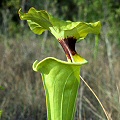
Sarracenia flava
A: Common names for plants---grass, oak, skunk cabbage, and waterlily--may
be fine for the masses, but when you want to discuss plants with any degree of
seriousness or care you must use Latin names.
"But whyyyyyy?" you might whine? Three reasons spring to mind
immediately.
Lesson #1a:Why common names stink
One problem with common names is that
not every organism has one. For example, I am thinking of a tiny little
daisy-relative
that no one apparently has ever cared enough about to give a common name. Poor forlorn
little thing!
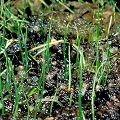
"resupinate
bladderwort"?
Consider an obscure species that has only recently
been named. What is the point of giving this plant a "common" name
when it has not been referred to, commonly, by anyone? In such odd cases,
common names are sometimes coined on the spot, usually with horrific results like
"resupinate bladderwort" (for Utricularia resupinata) or
"sub-glabrous corkscrew plant" (for Genlisea subglabra). Oh
yeah, you are really likely to hear a couple of huntsmen walking along, talking
about life, then have one point to the ground and say, "Hey Ted, could you
pick up my keys? I dropped them on those sub-glabrous corkscrew plants."
Writers and reporters
occasionally ask me for the common name of a plant that does not have one.
When I say it doesn't have a common name I am often asked to make one up.
This drives me batty. How can it be a common name if I just made it up?
Let me repeat: Not all plants have common names!
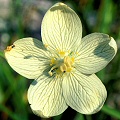
This is a "grass??"
Lesson #1b: Why Latin names are great
In contrast with common names,
every organism known to science has a Latin name. The name might look a little
strange, but so did my first girlfriend.
Indeed, after you get used to seeing the Latin name, it no longer looks so
strange (this is a definite contrast, I should point out, to my experiences with
aforementioned girlfriend #1). The names chrysanthemum, ranunculus, and iris are
not so difficult, are they? Guess what--they are derived from the Latin genus names for these plants! You are just used
to them, and they don't seem strange anymore.
Here's another example. That pretty cream-colored flower to the right has the lovely sounding name
"Parnassia palustris." Say it a few times to really appreciate the pretty rhythm of the name.
What is its common name, you ask? Ah, it is called "Californian smooth grass of Parnassus." What!? This thing isn't
from Parnassus (Greece)! And HELLO, it isn't a grass! What a dorky common name.
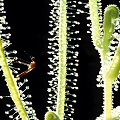
"sundew"
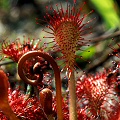
"sundew"
Lesson #2a: Why common names stink
Another problem with common names is that different species
of plants (plants that might not even be related) might have the same common name.
Examples include two different plants which are both called skunk cabbage, many different plants
which are called tumbleweed, dozens of plants which are all called daisies, and hundreds of plants
which are all just called moss.
In the world of carnivorous plants, I have heard both
Sarracenia and Darlingtonia called cobra lilies, about eight
different species of Sarracenia called trumpet pitcher plants, and
just about every kind of carnivorous plant has been called a flytrap by someone.
But as I said before, every form of life known to science has
its own Latin name.
Lesson #2b: Why Latin names are great
While every organism known
to science has a Latin name, it is important to know that no two species of plants share the same
Latin name. This means that the Latin name is unambiguous.
There is only one organism called Drosera barbigera, meanwhile the only
common name it has is "pygmy sundew," and it shares this common name with
dozens of other species, including Drosera pygmaea.
Sure, I'll grant you that some plants have more than one Latin name. This reflects the fact that not
all scientists agree on everything. This is fine: civil disagreement is essential to the scientific process. Suppose
I read a paper that talks about a plant that the author treats as a variant of Sarracenia purpurea
and refers to as
Sarracenia purpurea subsp. venosa var. burkii.
If I am of the botanical camp that thinks this plant should be considered a separate species, I can happily refer to the
same plant as Sarracenia rosea. This is because both names have been described for this plant, and
there are databases (conveniently on-line) that let you cross-reference these names. There is no confusion!
Lesson #3a: Why common names stink
I'll give you a hint on this third
one. Suppose I get a letter from someone in Oaxaca, Mexico, and this person
writes, "Hola Barry! Quiero ver "mala mujer". Donde vive esta
planta?" Get the problema? Different languages result in different common
names. What the heck is "mala mujer"? This is a fine common name
for my Oaxaca buddy, but not for a non-Spanish speaker.
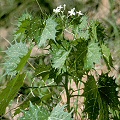
Cnidoscolus
angustidens
Lesson #3b: Why Latin names are great
My plant geek friend in Oaxaca
would add in her letter, "El nombre Latino es
Cnidoscolus angustidens." Ah, I know what she's habla-ing about
Incidentally,
bird-watching enthusiasts will tell you that they have developed a compromise
that takes care of at least the first two sets of problems I describe above.
Every bird species
is given an official common name. In this case, the "common name"
might be more accurately
thought of as the official, English language version of the Latin name. Apparently it is
easier to remember "Northern Rough-Winged Swallow" than it is to
remember Stelgidopteryx serripennis. It certainly is easier to say.
Page citations: Personal ranting.